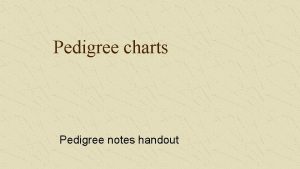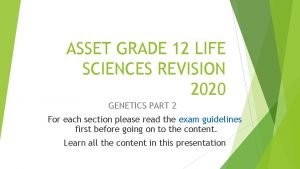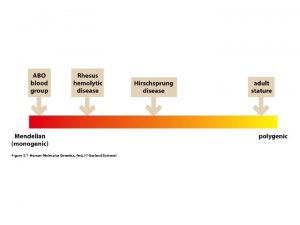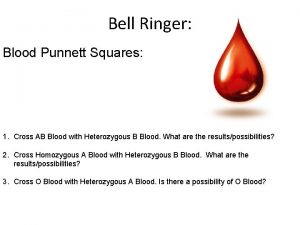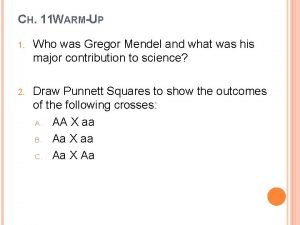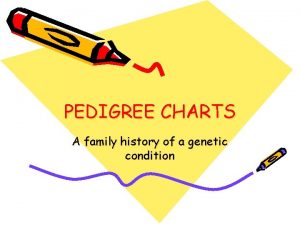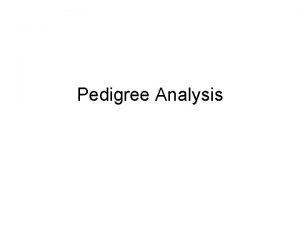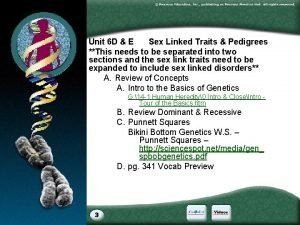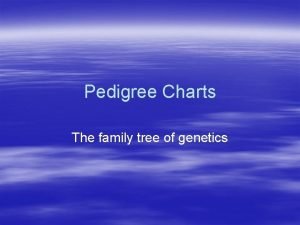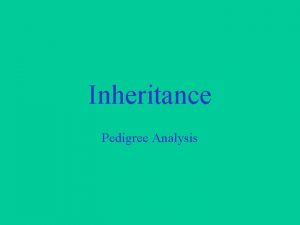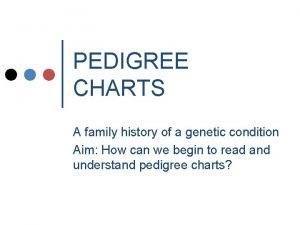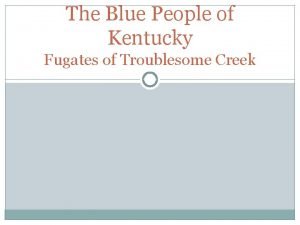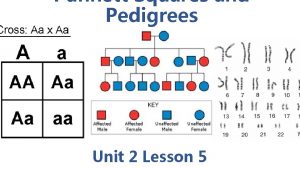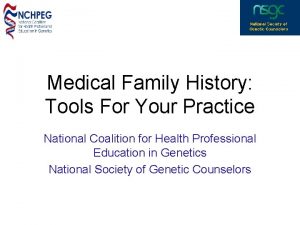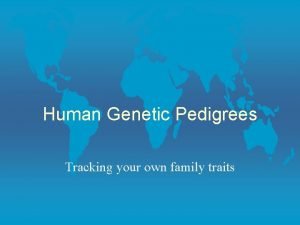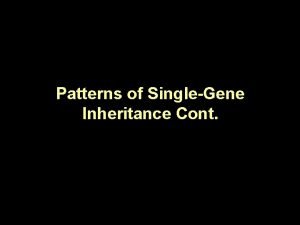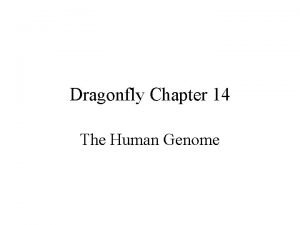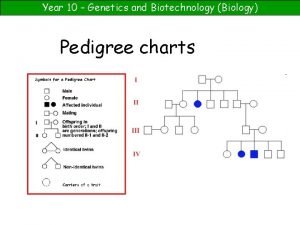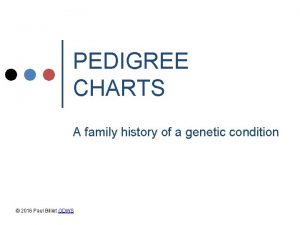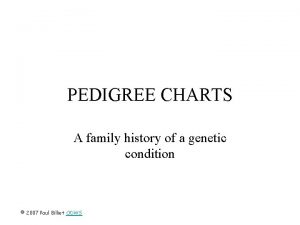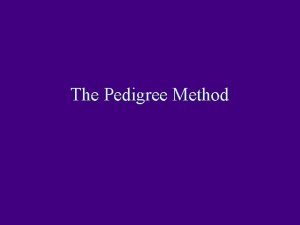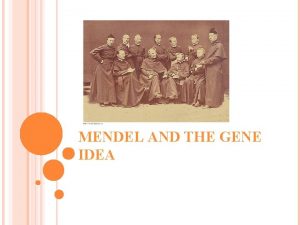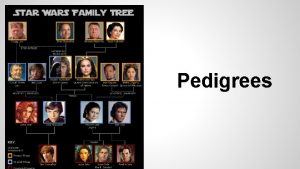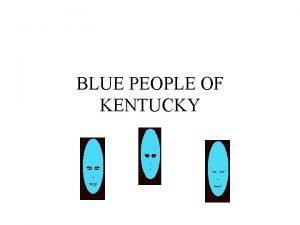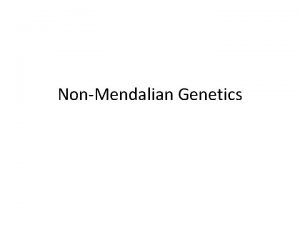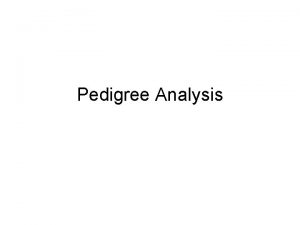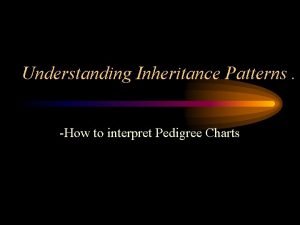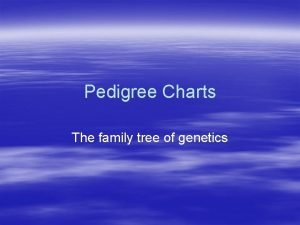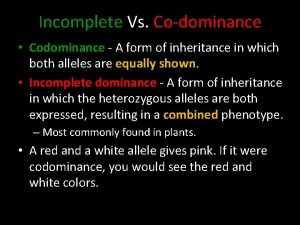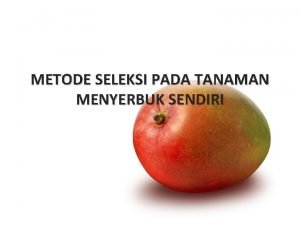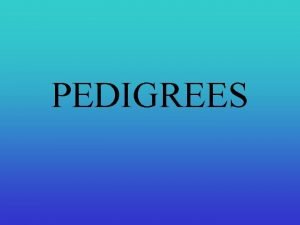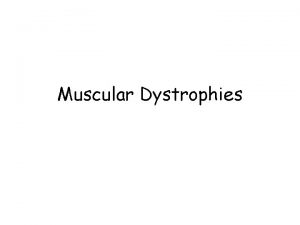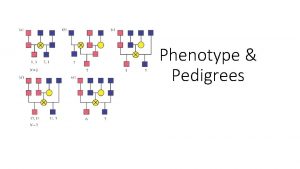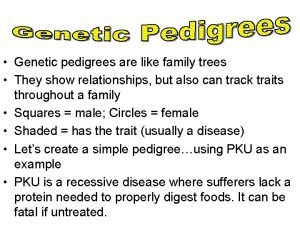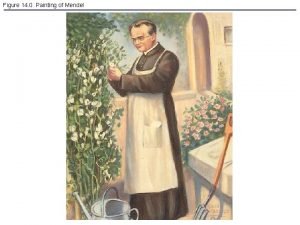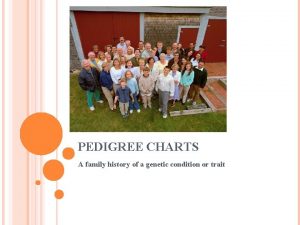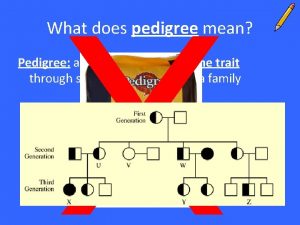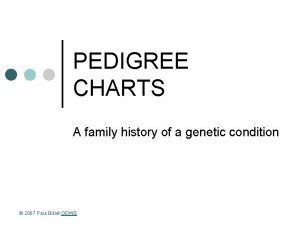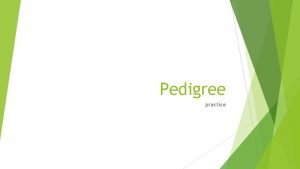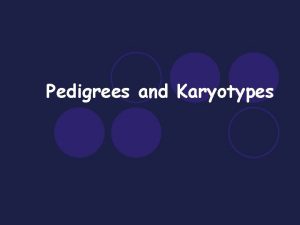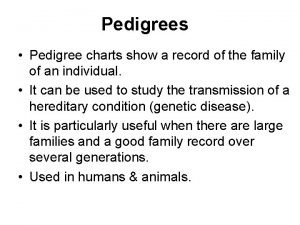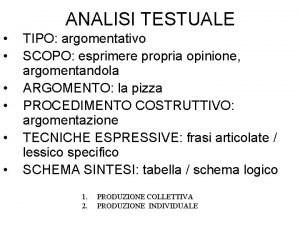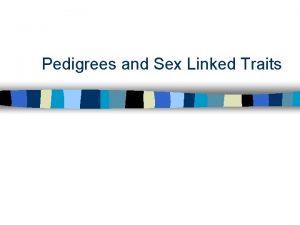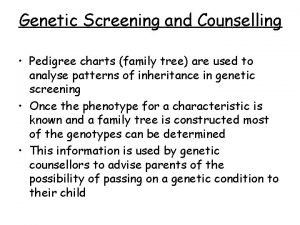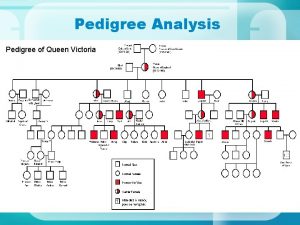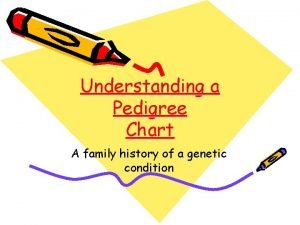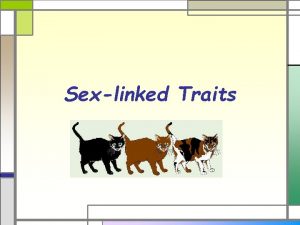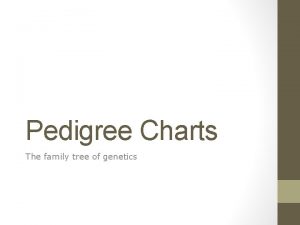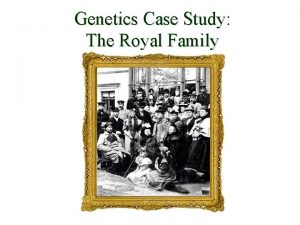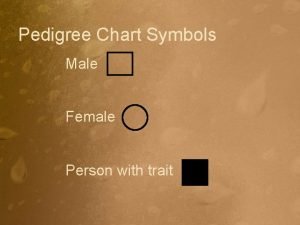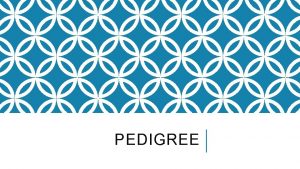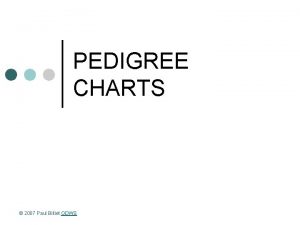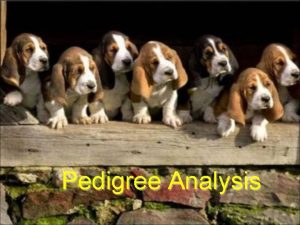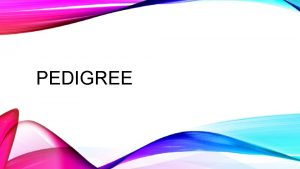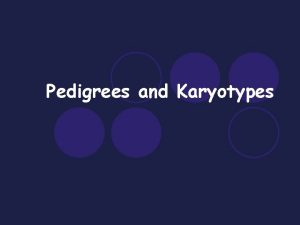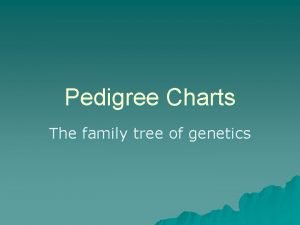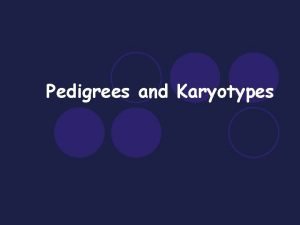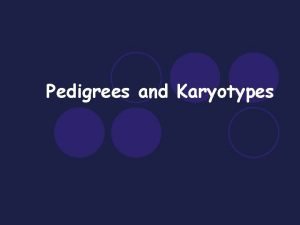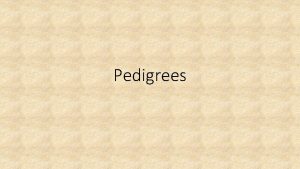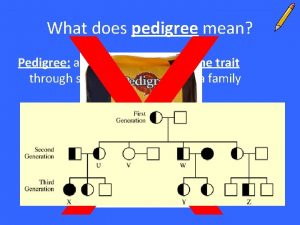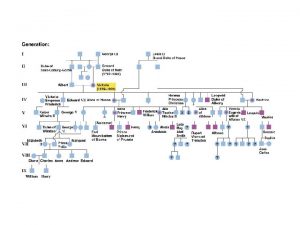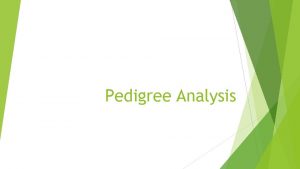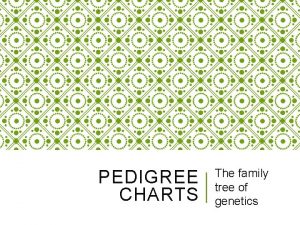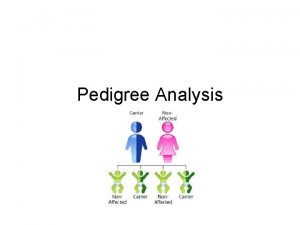Pedigree Notes What is a pedigree A pedigree






















































- Slides: 54

Pedigree Notes

• What is a pedigree? A pedigree is a diagram of family relationships that uses symbols to represent the people and lines to represent genetic relationships. • What symbols are used for males and female on a pedigree? = female = affected male • How is a married couple indicated on a pedigree? Draw you answer. By a solid horizontal line

• How would you draw a married couple with 3 children on a pedigree? Draw you answer. • What is a ‘carrier’? This is not in your text – THINK! A carrier is someone who “carries” the alleles for the recessive trait and can pass it on. They ARE NOT affected.

Look at figure 14 -3. What are the genotypes of both parents on the left in the second row? How do you know? rr x rr Because they are both showing the recessive phenotype (they are shaded).

• Autosomal or X-linked: – autosomal – involving chromosomes that are not the sex chromosomes – x-linked – involving traits linked to the sex chromosomes; specifically the X chromosome • Dominant or Recessive: – an allele that is always expressed when it is present. • Dominant alleles are usually represented by capital letters, such as F. – an allele that is not expressed when the dominant allele is present. • Recessive alleles are usually represented by lowercase letters, such as f.

• Draw a pedigree that represents Mary married to Greg, with 2 sons and 1 daughter. Their son, Scott married April and had Sutton (a boy) and Kendall (a girl). Their daughter, Karen, married Harry and had Tom (a son) and Jerry (a son). Please label the pedigree with the names of the people Mary April Kendall Scott Rr rr rr Harry rr rr rr Rr Sutton Tom Rr RR Greg Karen Rr Jerry RR Tyler

• Draw a pedigree that represents Julie married to Jeff, with one daughter, Josephine married Joseph and had Jason and How married Julia and had Shannon and fraternal twin boys, Mark and Alex. Mark married Alison and had Ray and Scarlet. Please label the pedigree with the names of the people. Jeff Julie Josephine Joseph Jason How Shannon Julia Alex Mark Ray Alison Scarlet

• Label the genotypes 1. bb 2. BB 3. Bb 4. bb 5. Bb 6. Bb 7. Bb 8. Bb 9. Bb 10. bb 11. Bb 12. Bb 13. bb 14. Bb or BB 15. Bb or BB 16. bb

• The below pedigree is for hemophilia, an x-linked recessive disease. Label the genotypes for each person. Use a combination of the following alleles: XN, Xn, or Y. (Remember: Male = XY, Female = XX) 1. Xn. Y 2. XNXn 3. XNXn 4. Xn. Y 5. Xn 6. XNY 7. XNXn 8. XNY 9. Xn. Y 10. XNXn 11. XNY 12. XNXn or XNXN 13. Xn. Y 14. XNXn or XNXN

• How would you be able to tell, if you were not told, whether a pedigree was for an x-linked trait or not? • Males have just one X chromosome. Thus, all X-linked alleles are expressed in males, even if they are recessive.

• Draw the pedigree below & Label the genotypes of the people when possible. If impossible to tell, put a question mark. Use F for the normal allele, and f for the cystic fibrosis allele. Grandma and Grandpa Miller are both healthy. They had four children: Hank, Scottie, Julia and Fred had cystic fibrosis and dies at the age of five. Hank married Maria, and they have three healthy children: Ethyl, Joyce and Fran. Scottie married Cindy and have two healthy children: Little Joe and Sally. Julia married John and Had two children: Frank and Susan. Frank has cystic fibrosis. Ff Maria Hank ff F? F? Julia Ff John Fred F? Ff F? ff Frank Cindy Scottie F? Ff F? F?

Monohybrid Cross

1. Rr x rr R r r Rr rr • Genotype: 50% Rr, 50% rr 1: 1 • Phenotype: 50% round seed coat shape, 50% wrinkled seed coat shape 1: 1

2. Rr x Rr R RR Rr r Rr Rr • Genotype: 25% RR, 50% Rr, 25% rr 1: 2: 1 • Phenotype: 75% round seed coat shape, 25% wrinkled seed coat shape 3: 1

3. Tt x Tt T TT Tt tt • Genotype: 25% TT, 50% Tt, 25% tt 1: 2: 1 • Phenotype: 75% Tall height, 25% short height 3: 1

4. Gg (heterozygous) x Gg (Heterozygous) G g G GG Gg gg • Genotype: 25% GG, 50% Gg, 25% gg 1: 2: 1 • Phenotype: 75% Green pod color, 25% Yellow pod color 3: 1

5. GG (homozygous green) x Gg (heterozygous) G g G GG Gg • Genotype: 50% GG, 50% Gg 1: 1 • Phenotype: 100% Green pod plant

6. TT (homozygous tall) x tt (homozygous short) T T t Tt Tt • Genotype: 100% Tt • Phenotype: 100% Tall Plant

7. Bb (Brown seed) x bb (white seed) B b b Bb bb • Genotype: 50% Bb, 50% bb 1: 1 • Phenotype: 50% Brown seed plant, 50% white seed plant 1: 1

8. Yy (heterozygous) x yy (white fruit plant) Y y y Yy yy • Genotype: 50% Yy, 50% yy 1: 1 • Phenotype: 50% yellow fruit, 50% white fruit 1: 1

9. Ll (heterozygous) x Ll (heterozygous) L l L LL Ll ll • Genotype: 25% LL, 50% Ll, 25% ll 1: 2: 1 • Phenotype: 75% long wing flies, 25% short wing flies 3: 1

10. Tt (heterozygous for tongue rolling) x tt (cannot roll tongue) T t t Tt tt • Genotype: 50% Tt, 50% tt 1: 1 • Phenotype: 50% roll tongue, 50% cannot roll tongue 1: 1

Dihybrid Cross

a. b. c. d. e. f. FFtt Ff. Tt Fftt Ff. TT FFTt a. b. c. d. e. f. hh. FF HHff Hhff HHFf hh. Ff Hh. Ff

3 a. aa. Hh (albino that is heterozygous for curly hair) x AAhh (homozygous for normally pigmented skin with straight hair) (a. H, ah, a. H, ah) x (Ah, Ah, Ah) a. H ah Ah Aa. Hh Aahh Aa. Hh Aahh • Genotypes: 50% Aa. Hh, 50% Aahh 1: 1 • Phenotypes: 50% normal skin & curly hair, 50% normal skin & straight hair 1: 1

3 b. aahh (albino with straight hair) x AAHH (pure curly hair, homozygous dominant for skin coloring) (ah, ah, ah) x (AH, AH, AH) ah AH ah ah ah Aa. Hh AH AH AH • Genotypes: 100% Aa. Hh • Phenotypes: 100% normal pigmented skin with curly hair

3 c. Aa. Hh (F 1 hybrid) x Aa. Hh (F 1 hybrid) (AH, Ah, a. H, ah) x (AH, Ah, a. H, ah) AH Ah a. H ah AH AAHh Aa. HH Aa. Hh Ah AAHh Aahh Aa. Hh Aahh a. H Aa. Hh aa. HH aa. Hh ah Aa. Hh Aahh aa. Hh aahh • Genotypes: aahh, AAhh, aa. Hh, AAHh, aa. HH, AAHH • Phenotypes: Normal skin/curly, albino/curly, normal skin/straight, albino/straight 9: 3: 3: 1

4 a. Ddff (no freckles and heterozygous for dimples) x ddff (no freckles and no dimples) (Df, df, Df, df) x (df, df, df) Df df df Ddff ddff Ddff ddff • Genotypes: 50% Ddff, 50% ddff 1: 1 • Phenotypes: 50% dimples and no freckles, 50% no dimples and no freckles 1: 1

4 b. dd. Ff (no dimples that has freckles) x DDFF (homozygous dominant for both traits) (d. F, df, d. F, df) x (DF, DF, DF) DF d. F df Dd. FF Dd. Ff DF DF DF • Genotypes: 50% Dd. FF, 50% Dd. Ff 1: 1 • Phenotypes: 100% dimples and freckles

4 c. ddff (homozygous recessive for both traits) x ddff (homozygous recessive for both traits (df, df, df) x (df, df, df) df df ddff • Genotypes: 100% ddff • Phenotypes: 100% no dimples and no freckles

Bikini Bottom WS 1

1. TT – Ho dd – Ho BB – Ho Bb – He Dd – He FF – Ho DD – Ho ff – Ho Ff – He Tt – He tt- Ho bb – Ho Purebred = homozygous dominant & homozygous recessive Hybrids = heterozygous

2. YY = Yellow Yy = Yellow yy = blue 3. Tall = Tt, TT Short = tt

Matching 1. G 2. E 3. L 4. I 5. A 6. H 7. J 8. K 9. B 10. F 11. D 12. C

1. BB x bb a) B B b Bb Bb b) 100% c) No they would not be considered purebreds because they have the heterozygous genotypes. They would be hybrids.

2. Pp x Pp a) b) 25% P p p Pp pp

3. Yy x yy a) b) 50% Y y y Yy yy

4. TT x Tt a) b) No T TT TT t Tt Tt

5. Ee x EE a) E e E EE Ee b) Yes, they made a mistake

6. ll x ll a) l ll ll ll b) No, because there is no dominant allele present c) Homozygous Dominant (LL)

7. ll x ll a) Ss S s s Ss ss b) Ss c) Ss x Ss S SS Ss s Ss Ss Genotype: SS, Ss, ss 1: 2: 1 Phenotype: Squarepants, Roundpants 3: 1

Bikini Bottom WS 2

1. ssll x SSLL (sl, sl, sl) x (SL, SL, SL) a) sl SL b) 100% c) 0% Ss. Ll

2. Yy. Ss x yyss (YS, Ys, y. S, ys) x (ys, ys, ys) a) ys YS Yy. Ss Ys Yyss y. S yy. Ss ys yyss b) 50% c) 50% d) 25% e) 25%

3. Pp. TT x pptt (PT, p. T, PT, p. T) x (pt, pt, pt) pt PT Pp. Tt p. T pp. Tt PT p. T a) No, because they will all have thick eyebrows b) Yes, all of their offspring will have thick eyebrows.

4. a) Yes, because for all of their offspring to have hair he must mate with a homozygous dominant female. b) No, because squidward is homozygous dominant. If he marries a homozygous recessive all of their offspring will be heterozygous – which will still show the dominant phenotype.

5. BBhh x bb. Hh (Bh, Bh, Bh) x (b. H, bh, b. H, bh) Bh b. H Bb. Hh bh Bbhh b) They could possible be purebred for being bald c) 50%

6. dd. Ff x DDFF (d. F, df, d. F, df) x (DF, DF, DF) DF b) 0% c) 100% d. F Dd. FF df Dd. Ff

Extension to Mendel

Palamino Horses - Incomplete dominance 1. Because it is a blend between white and brown. Neither allele is showing complete dominance. 2. BB x bb B B Bb = 100% b Bb Bb 100% Palamino b Bb Bb 3. Parent #1: Bb Parent #2: Bb Both are heterozygous 4. Mendel stated that one allele is dominant which will mask the recessive allele. With incomplete dominance that does not occur.

Spotted Horses - Codominance 5. BB x BW BB = 50%; Black BW = 50%; Spotted B W B BB BW 6. Codominance both alleles are expressed in the heterozygous genotype. Incomplete dominance neither alleles are completely expressed over the other in the heterozygous genotype – the dominant and recessive phenotype blend together.

Blood-Typing – Multiple Alleles 7. Multiple Alleles 8. Phenotype 9. Genotype A Blood Type IAIA or IAi B Blood Type IBIB or IBi AB Blood Type I AI B O Blood Type ii i i IA I Ai IB IB i 10. Wrong baby – No offspring will result in ii (O Blood Type) IB i IA I AI B I Ai IB IB IA I AI B IB IB IB

Skin Color – Polygenic Traits 11. It is called polygenic. An example is skin color or eye color. 12. No. There will only be hybrids (heterozygous genotypes) 13. Yes because in the F 2 generation the recessive phenotypes will reappear.

X-Linked Traits 14. XHXh crossed with XHY phenotypes: Homozygous dominant female – no Hemophilia Heterozygous female – no Hemophilia Male without hemophilia Male with hemophilia 15. XHXh or Xh. Y 16. Xc or XCY 50% Xc. XC , 50% Xc. Y 50% chance of having a color-blind child 17. They are referred to as “sex-linked” or “xlinked” because the trait is linked to the X chromosome!
 What do the shaded shapes represent in a pedigree
What do the shaded shapes represent in a pedigree Wisc
Wisc Pedigree diagram grade 12
Pedigree diagram grade 12 Xlinked pedigree
Xlinked pedigree Benjamin stacy
Benjamin stacy Pedigree representation
Pedigree representation The pedigree below traces the inheritance of alkaptonuria
The pedigree below traces the inheritance of alkaptonuria Fraternal twins pedigree chart
Fraternal twins pedigree chart Half filled circle in pedigree
Half filled circle in pedigree Sex linked pedigree
Sex linked pedigree Phenylketonuria pedigree chart
Phenylketonuria pedigree chart What do squares represent in a pedigree
What do squares represent in a pedigree Pedigree chart of rolling tongue
Pedigree chart of rolling tongue Blue skinned people
Blue skinned people Gender punnett square
Gender punnett square 1st degree relative
1st degree relative Pedigree for nearsightedness answers
Pedigree for nearsightedness answers Maternally imprinted pedigree
Maternally imprinted pedigree In a pedigree, a vertical line and a bracket connect _____.
In a pedigree, a vertical line and a bracket connect _____. Part 10 pedigree charts
Part 10 pedigree charts Tongue rolling pedigree chart
Tongue rolling pedigree chart Cystic fibrosis pedigree chart
Cystic fibrosis pedigree chart Pedigree method
Pedigree method Michael jackson pedigree
Michael jackson pedigree The pedigree below traces the inheritance of alkaptonuria
The pedigree below traces the inheritance of alkaptonuria Pedigree chart genotype
Pedigree chart genotype Blue people of kentucky pedigree
Blue people of kentucky pedigree Flipnob family pedigree answer key
Flipnob family pedigree answer key X linked dominant pedigree
X linked dominant pedigree Hypertrichosis pedigree chart
Hypertrichosis pedigree chart Pedigree fraternal twins
Pedigree fraternal twins Codominance simple definition
Codominance simple definition Metode seleksi massa
Metode seleksi massa Symbols in pedigree
Symbols in pedigree Muscular dystrophy classification
Muscular dystrophy classification Phenotype pedigree chart
Phenotype pedigree chart Pedigree key
Pedigree key Mendels law
Mendels law Pedigree chart of down syndrome
Pedigree chart of down syndrome Cystic fibrosis pedigree chart
Cystic fibrosis pedigree chart Family history
Family history Pedigree practice
Pedigree practice Klinefelter syndrome pedigree
Klinefelter syndrome pedigree Pedigree chart symbols
Pedigree chart symbols Pedigree kahoot
Pedigree kahoot Bachi spaziali
Bachi spaziali Pedigree circle square
Pedigree circle square Genetic symbols
Genetic symbols Queen victoria's pedigree
Queen victoria's pedigree Fraternal twins pedigree
Fraternal twins pedigree Is cystic fibrosis autosomal or sexlinked
Is cystic fibrosis autosomal or sexlinked Pedigree chart for twins
Pedigree chart for twins Romanov family pedigree
Romanov family pedigree Free earlobes dominant or recessive
Free earlobes dominant or recessive Pedigree chart symbols
Pedigree chart symbols
